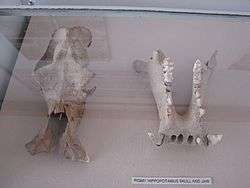Cyprus dwarf hippopotamus
The Cyprus dwarf hippopotamus or Cypriot pygmy hippopotamus (Hippopotamus minor) is an extinct species of hippopotamus that inhabited the island of Cyprus until the early Holocene.
| Cyprus dwarf hippo | |
|---|---|
| Composite mounted skeleton of H. minor | |
| Scientific classification | |
| Kingdom: | Animalia |
| Phylum: | Chordata |
| Class: | Mammalia |
| Order: | Artiodactyla |
| Family: | Hippopotamidae |
| Genus: | Hippopotamus Linnaeus, 1758 |
| Species: | †H. minor |
| Binomial name | |
| †Hippopotamus minor | |
| Synonyms | |
|
Phanourios minor Sondaar and Boekschoten, 1972 | |
The 200-kilogram (440 lb) Cyprus dwarf hippo was roughly the same size as the extant pygmy hippopotamus. Unlike the modern pygmy hippo, the Cyprus dwarf became small through the process of insular dwarfism. This same process is believed to cause the dwarfism found in some dwarf elephants, the pygmy mammoth, and Homo floresiensis. The animal is estimated to have measured 76 cm (2.5 ft) tall and 121 cm (4.0 ft) long.[2]
H. minor is the smallest hippopotamus of all known insular hippopotamuses. The extremely small size of the hippo is in favour of a Middle Pleistocene or perhaps even Early Pleistocene colonization.[3] At the time of its extinction between 11,000 and 9,000 years ago, the Cyprus dwarf hippo was the largest animal on the island of Cyprus. It was a herbivore and had no natural predators.[4]
Excavation sites on Cyprus, particularly Aetokremnos, provide evidence that the Cyprus dwarf hippo may have encountered and been driven to extinction by the early human residents of Cyprus.[5][6][7]
A similar species of hippo, the Cretan dwarf hippopotamus (Hippopotamus creutzburgi) existed on the island of Crete, but became extinct during the Pleistocene.
Alternative name

Many scientists maintain the name Phanourios minor for the Cypriot dwarf hippo. This generic name was given by Paul Sondaar and Bert Boekschoten in 1972,[8] based on the remains from Agios Georgios, Cyprus. At the site, a chapel had been built into the fossiliferous rocks. The rock strata here are very rich in bone content (bone breccia). For centuries, as already mentioned by Bordone in the 16th century,[9] villagers have gone there to collect these bones, which in their opinion are holy, because they are the petrified remains of Saint Fanourios (see also Phanourios (saint)), a Greek Orthodox Saint who, according to local myth, had fled from Syria to escape his persecutors, but had been stranded on the hostile rocky coast of Cyprus. The collected bones are ground into a powder believed to have medicinal powers. To honour the local tradition and to refer to the site, Sondaar and Boekschoten named their new genus Phanourios, following the Greek spelling. They gave the specific name minutus, but this was later changed to minor following rules of priority.
See also
- Cretan dwarf hippopotamus
- Maltese dwarf hippopotamus
- Sicilian dwarf hippopotamus
- Cyprus dwarf elephant
References
- Desmarest, A.G., 1822. Mammalogie ou description des espèces de mammifères. Mme Veuve Agasse imprimeur édit., Paris, 2ème part., pp.277-555.
- Hadjicostis, Menelaos (6 December 2007). "Dwarf Hippo Fossils Found on Cyprus". Fox Television. The Associated Press. Retrieved 2007-12-06.
- Van der Geer A., Lyras G., De Vos J., Dermitzakis M. 2010. Evolution of Island Mammals: Adaptation and Extinction of Placental Mammals on Islands. Wiley-Blackwell.
- Burness, G. P.; Diamond, J.; Flannery, T. (2001-12-04). "Dinosaurs, dragons, and dwarfs: The evolution of maximal body size". Proceedings of the National Academy of Sciences. 98 (25): 14518–14523. doi:10.1073/pnas.251548698. ISSN 0027-8424. JSTOR 3057309. PMC 64714. PMID 11724953. Retrieved 2012-01-28.
- The earliest prehistory of Cyprus from colonization to exploitation, ed. Swiny, Stuart, American Schools of Oriental Research, 2001, In PDF
- Simmons, A. H. (1999). Faunal extinction in an island society: pygmy hippopotamus hunters of Cyprus. Interdisciplinary Contributions to Archaeology. Kluwer Academic/Plenum Publishers. p. 382. doi:10.1007/b109876. ISBN 978-0306460883. OCLC 41712246.
- Simmons, A. H.; Mandel, R. D. (December 2007). "Not Such a New Light: A Response to Ammerman and Noller". World Archaeology. 39 (4): 475–482. doi:10.1080/00438240701676169. JSTOR 40026143.
- Boekschoten G.J., Sondaar P.Y. 1972. On the fossil mammalia of Cyprus, I & II. Proceedings of the Koninklijke Nederlandse Akademie van Wetenschappen (Series B), 75 (4): 306–38.
- Bordone B. 1528. Libro di Benedetto Bordone. Nel qual si ragiona di tutte l'Isole del mondo, con li lor nomi antichi & moderni, historie, favole, & modi del loro vivere. Niccolo Zoppino, Venice. In facsimile, Edizioni Aldine, Modena, 1982.